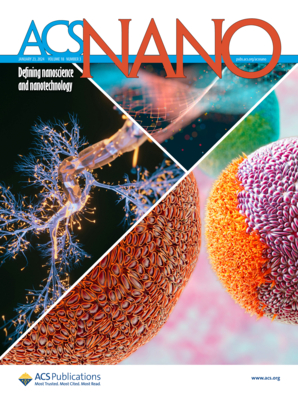Uncovering the Effect of Crystallinity on the Pseudocapacitive Behavior of Li+ Storage on Disordered Rock-Salt Vanadium Oxide.
IF 16
1区 材料科学
Q1 CHEMISTRY, MULTIDISCIPLINARY
引用次数: 0
Abstract
Lithium-rich disordered rock-salt (DRS) materials exhibit potential for fast-charging Li-ion batteries and capacitors, primarily arising from their pseudocapacitive Li+ charge-storage behavior in a low-potential region (<1.0 V versus Li/Li+). This behavior originates from a three-dimensional (3D) Li+-percolation diffusion network, a mechanism defined as percolation pseudocapacitance. However, the relationship between the structural characteristics and pseudocapacitive behaviors remains unclear. Here, we design a series of DRS-Li3V2O5 with different degrees of crystallinity through adjusting the crystallization of V2O5 precursors. We show that DRS-Li3V2O5 with a lower degree of crystallinity exhibits quasi-rectangular cyclic voltammetry (CV) curves and sloped galvanostatic charge/discharge (GCD) profiles, characteristic of surface redox pseudocapacitance. On the contrary, DRS-Li3V2O5 with a higher degree of crystallinity shows a couple of redox peaks with a small voltage offset observed in CV curves and approximately plateau-like GCD profiles, which are characteristic of intercalation pseudocapacitance. Besides, a lower degree of crystallinity leads to a higher specific capacity at a low rate but a poorer rate capability at a high rate, whereas a higher degree of crystallinity leads to a higher pseudocapacitive contribution and a longer cycling lifespan. We propose that a higher degree of crystallinity can promote the formation of a more integrated percolation network on DRS electrodes, which provides faster 3D Li+ transport pathways.揭示结晶度对无序岩盐氧化钒Li+存储赝电容行为的影响。
富锂无序岩盐(DRS)材料显示出快速充电锂离子电池和电容器的潜力,主要是由于它们在低电位区域(<1.0 V vs Li/Li+)的赝电容性Li+电荷存储行为。这种行为源于三维(3D) Li+渗透扩散网络,这种机制被定义为渗透赝电容。然而,结构特性与赝电容行为之间的关系尚不清楚。本文通过调整V2O5前驱体的结晶,设计了一系列不同结晶度的DRS-Li3V2O5。研究表明,结晶度较低的DRS-Li3V2O5具有准矩形循环伏安(CV)曲线和倾斜的恒流充放电(GCD)曲线,具有表面氧化还原赝电容的特征。相反,结晶度较高的DRS-Li3V2O5在CV曲线和近似于平台的GCD曲线上显示出一对电压偏小的氧化还原峰,具有插层伪电容的特征。此外,较低的结晶度导致低速率下较高的比容量,而高速率下较差的速率能力,而较高的结晶度导致较高的假电容贡献和较长的循环寿命。我们提出,更高的结晶度可以促进DRS电极上更完整的渗透网络的形成,从而提供更快的3D Li+传输途径。
本文章由计算机程序翻译,如有差异,请以英文原文为准。
求助全文
约1分钟内获得全文
求助全文
来源期刊

ACS Nano
工程技术-材料科学:综合
CiteScore
26.00
自引率
4.10%
发文量
1627
审稿时长
1.7 months
期刊介绍:
ACS Nano, published monthly, serves as an international forum for comprehensive articles on nanoscience and nanotechnology research at the intersections of chemistry, biology, materials science, physics, and engineering. The journal fosters communication among scientists in these communities, facilitating collaboration, new research opportunities, and advancements through discoveries. ACS Nano covers synthesis, assembly, characterization, theory, and simulation of nanostructures, nanobiotechnology, nanofabrication, methods and tools for nanoscience and nanotechnology, and self- and directed-assembly. Alongside original research articles, it offers thorough reviews, perspectives on cutting-edge research, and discussions envisioning the future of nanoscience and nanotechnology.
 求助内容:
求助内容: 应助结果提醒方式:
应助结果提醒方式:


